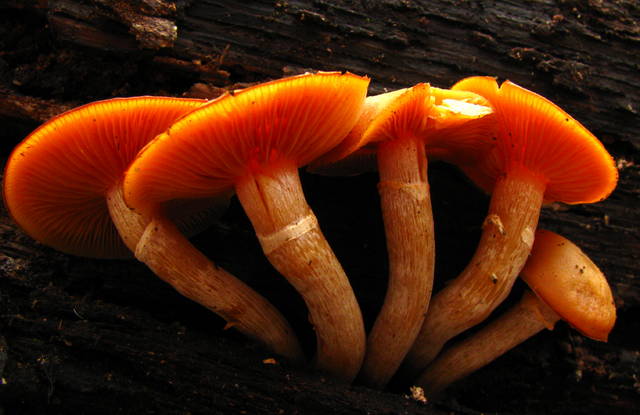Reproduction and Life Cycle
As we learned in the classification page, Galerina autumnalis is a member of the basidiomycota which determines the general life cycle of the mushroom. The image below is a drawn out example of the general life cycle of a member of the basidiomycota.
Tom Volk 1992.
 1.This
is the mature, fruiting body of the mushroom. This generally is the
structure that people can identify as a mushroom.
1.This
is the mature, fruiting body of the mushroom. This generally is the
structure that people can identify as a mushroom.
2. This is a cross section through the cap of the mushroom to make the gills visible.
3. The gills are then magnified where the basidiums become visible. The gills' epidermis is lined with these cells.
4. A larger view of the basidium shows how the basidiospores are attached.
5. The basidiospores are haploid (N) spores which germinate.
6. Through germination the spores then begin to develop primary, haploid mycelium.
7. Here there is a fusion of the cytoplasm of two of the primary mycelia cells through the process known as plasmogamy.
8. The clamp connection development is now present which acts as a passageway for the nuclei to travel along the mycelium.
9. This is now secondary mycelium. A fungi can spend infinite amount of time growing as a secondary mycelium until an environmental signal says otherwise. This would be a dikaryon (N+N).
10. After an environmental signal many mycelium can join together and begin to develop basidiocarps, which are also known as fruiting bodies.
11. These then are put through the process known as karyogamy which is when the two nuclei merge into one and become a diploid (N+N turns into 2N). Before they reach full maturity the gills are covered with a thin membrane called a partial veil and remnants are pictured below. These mushrooms mature enough to begin to bare spores and they are back to 1.
The sunlight usually serves as an indicatior that the fungi can form a fruiting body which will mature enough to produce spores. Gravity usually serves as a guide into which direction the fruiting body will grow. Other environmental signals are not completely understood.

Dan Molter 2009.
This image above shows the remnants of the partial veil, the faint white rings on the stipe, which actually extends similar to a veil that covers the gills before it is fully mature.
Back to interactions Go home Continue to facts
